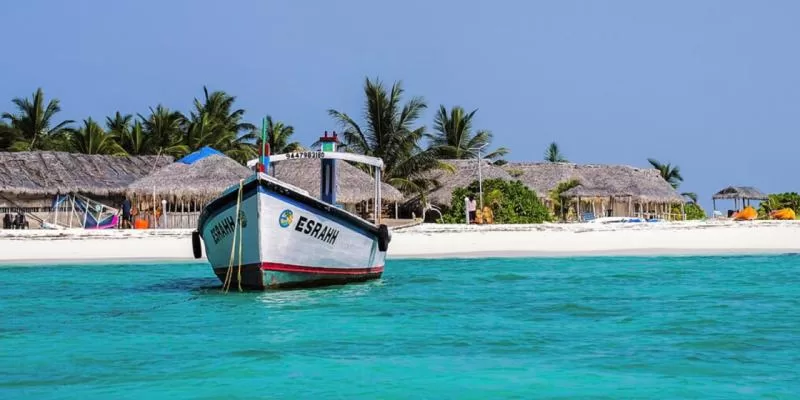When Prime Minister Narendra Modi recently visited Lakshadweep, his narrative of the exhilarating experiences set off a storm in neighbouring Maldives. On social media, Modi put out Lakshadweep images of white beaches, pristine blue skies, and the ocean. Modi’s intent was to get Indians to put Lakshadweep high on the catalogue of places they must as part of their vacation. His visit and subsequent call was as political as it was touristic.
How ready is Lakshadweep for mass tourism? Lakshadweep can only be reached by ships and flights operated from India’s lone gateway – Kochi. Only Indian airlines operate flights from Kochi. As a tropical archipelago of 36 atolls and coral reefs in the Laccadive Sea, those who travel to Lakshadweep must acquire permits to visit populated ten islands.
In 2021, a letter written by a collective of 58 lawyers and researchers urged the President of India to ensure “Peace, Progress & Good Governance”: They underscored that the island’s geography, ecology, and sociological factors placed likely limits on the kinds of distinctive development that the archipelago could accommodate. Meanwhile, there has been a massively indifferent response to the Lakshadweep Development Authority Regulation (LDAR) scheme to develop eco-tourism attractions such as water villas. A water villa offers water retreats of all the comforts that one desires. These magnificent villas, built on stilts, are within sight of a coral reef with its colorful marine life.
Large-scale tourism and its impact on the island’s ecology
Tourism as a form of luxury must be suitably moderated and controlled. Jose Dominic of CGH Earth Group, whose company used to run a resort in Lakshadweep, fervently promotes nature and the environment in his business and asserts that opulence must never override the interests of the planet and society. Like other naturalists and conservationists, CGH works on core values including respect for the environment, local community, and adoption of the local ethos.
Mainstream tourism shows disregard for the notion of carrying capacity and holds up profits as precedence. “Tourism Carrying Capacity”, according to the World Tourism Organization, is “the maximum number of people that may visit a tourist destination at the same time, without causing destruction of the physical, economic, socio-cultural environment and an unacceptable decrease in the quality of visitors’ satisfaction”. If Lakshadweep were to evolve into a space for large-scale tourism, and it emerges as a crowded space with all its appendages, it could gravely harm the island’s ecology.
There is a tendency for the tourism industry to push for dredging of the sea bed to enable the arrival of ships and cruise liners. Dredging and desilting can have serious and long-lasting negative impacts on the environment. For example, it can damage or destroy fish spawning grounds. Silt can become suspended in the water, lowering oxygen levels, and potentially releasing harmful chemicals that may be present.
Scientists and marine biologists are also opposed to dredging because coral reefs provide food and resources for more than 500 million people in over 100 countries and territories and are valued at an economic value of $375 billion a year. Dredging and desilting also have serious and long-lasting negatives by destroying fish spawning grounds and making river banks unstable.
According to the International Association of Dredging Companies, “Coral reefs are large, long-lived bio-geological structures that are marine ridges or mounds. They are formed from the deposition of calcium carbonate by living organisms, predominantly hard corals, but also by other organisms such as coralline algae and shellfish.” Further, “they are robust and have often withstood the forces of storms, climatic change, sea level change and predators, the living elements – coral, coralline algae and shellfish that build these structures – are just a very thin veneer of delicate tissue, highly sensitive to the surrounding environment. The destruction of coral reefs can be life-threatening to nature, sea life, and humans. Any form of their degradation must be deemed as ‘sacrilegious’.
The aggressive call to inflate tourism to levels which exceed carrying capacity levels would depressingly alter the serenity that now characterises the islands. There are only some selected locations that one can visit on the main island of Lakshadweep – Kavaratti is one of the more developed islands. It is home to dozens of mosques, including the Kavaratti Aquarium which showcases regional fish, shark and coral species. However, mass tourists crave to be entertained in a myriad of other ways. These can be inexpedient to the ecosystem.
The tragic case of Goa
Take the example of Goa. When tourism arrived in Goa in the 1960s, the hippies attracted young people with the cultural isolation, beauty of tropical nature, and the atmosphere of spirituality reigning there. People here are different, parties are more indie and yoga and spiritual. The hippie culture in Anjuna, Vagator, and Baga in North Goa, was all about freedom, spirituality and creativity. The town, notably Anjuna, still has its home-based guesthouses, cafes, and art galleries that are perfect for people who live a bohemian lifestyle. Hippie-styled people and hippies themselves, who came to Goa and still believe in the ideals of the hippie culture, run these places.
Tragically, in less than two decades, a short 108 km coastline of calm and serenity was trounced by crowds with large hotels and resorts. Coastal Goa is dotted with casinos, gambling parks, massage parlors, dance clubs, a drug trade, and an offensive sex industry. Today, a 1.4 million population are in overdrive as they host over 7 million tourists!
Back to Lakshadweep – PM Modi’s invitation to Indians to throng to Lakshadweep has created tensions with Maldives. Union minister Kishan Reddy declared that Lakshadweep has huge tourism potential and called on Indian travelers to explore Lakshadweep leaving aside other overseas destinations for exciting domestic holidays. This call raised a red flag in Maldives. It was perceived as an unannounced competition. Ostensibly Maldives perceived a threat to their tourism market – a market frequented by some 20,000 Indian tourists annually seeking tourist pleasures that Maldives has readied and made operational. Social media heated up.
Maldives still has the edge and Lakshadweep cannot rapidly reach Maldives’ levels of tourist influx easily. Maldives has close to 1,200 islands across 26 atolls spread over 9,000 sq km. Lakshadweep, by comparison, has a land area measuring 32 sq km. The only way Lakshadweep can compete with Maldives is by total destruction of the reefs and islands of Lakshadweep in less than a few years.
Lessons from the Maldives to Lakshadweep
Lakshadweep ought to absorb lessons from the horrors of what one finds hidden from view in what is euphemistically termed ‘Maldives – Always Natural’. Maldives conceals stench-filled smoke cascading into the water, swarms of flies, and toxic smoke from dumps of garbage. The Thilafushi Corporation, a body that works on the island and estimates the garbage coming to the island is about “300-400 tons of trash per day”. Rising sea levels endanger Thilafushi which will lead waste from the landfill into the Indian Ocean when they overspill and result in environmental havoc. The total plastic footprint in the Maldives is about 12% of the total waste amounting to nearly 43,134 tons per year (Maldives Ocean Plastics Alliance, 2021).
Maldives has become emblematic of the challenges that sea level rise will bring to many countries. The former president of the Maldives, Mohamed Nasheed, a champion of Island nations, speaking for 50 climate-vulnerable countries at a UN conference averred that those living in threatened coastal areas and islands “are paying with our lives for the carbon someone else emitted”.
Climate change is accelerating the rise in sea levels around the world, leaving some of the most vulnerable populations to live in marginal areas where flooding from high tides is increasing. Higher sea levels coincide with hurricanes and typhoons that result in more rain, contributing to storm surges that can strip away everything in their path.
According to the UNDP, Lakshadweep, just 1-2 meters above sea level on average –where every seventh person is a fisherman – is losing its coral reefs and facing varieties of climate change at multiple levels. Tourists, in general, are especially fascinated by corals and the colorful reefs. They are beautiful and biologically diverse habitats in the ocean, as well as some of the most ancient.
Lakshadweep used to be the perfect example of how coral islands are formed and how the corals nurture marine life and also the people who depend on them. Corals, and the atolls and lagoons they form, are now in grave danger from global warming. In October, the Intergovernmental Panel on Climate Change, the world’s largest body of climate scientists and experts, dropped a bombshell in a special report called Global Warming of 1.5ºC citing risks. The report delivered at the United Nations’ 48th session of the IPCC offered an “authoritative, scientific guide for governments” to deal with climate change.
Sadly, Corals and coral reefs near Kavaretti are reportedly irreversibly endangered and activists are finding them hard to restore. Preserving delicate habitats such as coral reefs can be a challenging task for scientists. One of the most significant challenges is the sheer size and complexity of coral reefs. Coral reefs are some of the most bio-diverse environments on Earth, and they support a staggering array of plant and animal species.
For mass tourism in Lakshadweep to take off, an airport which can cope with heavy aircraft will be required. Airplanes burn fossil fuel which not only releases CO2 emissions but contributes to climate change. Suggestions that air connectivity must be enhanced are being propagated. For people in Lakshadweep, all this is a potential nightmare. Indian corporations from the mainland are placing profits over people and the ecosystem. Fears of cruise lines stepping in will mean redeveloping the island’s port to accommodate huge ships. Coral dredging to accommodate this will cause irreversible damage that cannot be altered.
Amidst the disparaging remarks aimed at India by Maldivian politicians on Twitter, EaseMyTrip CEO hastily terminated all packages to the Maldives. Several Indian travelers canceled their Maldives bookings.
Meanwhile, the Maldives social media users reject India’s attempt to “compete” with their country as a choice for tropical vacations. Zahid Rameez of the Progressive Party of Maldives (PPM), indecorously declared: “The move is great. However, the idea of competing with us is delusional. How can they provide the service we offer? How can they be so clean?” Rameez’s posts instigated a range of racist remarks against Indians and Indian tourists. Indian tourists have remained among the top ten nationalities travelling to Maldives every year. In 2023 alone, Indians formed the largest group of tourists with over 200,000 travelers, followed by tourists from Russia and China. The Maldives is profoundly dependent on tourism and the industry accounts for over 28 percent of its GDP.
India tourism planners need to view Lakshadweep as a space that typifies the most ideal form of tourism. It’s magnificent: expansive sandy beaches, coral reefs and create the opportunity for scuba diving, and windsurfing – thrills that are not available just about anywhere except in the coastal areas and Small Islands. India cannot just open the floodgates to tourism. It must be scientifically paced. There is an obligation to protect the Islands’ fragile ecology and limited assets. It’s no shame to say we have insufficient space. To promote ‘responsible Tourism’ is more crucial.
Any plan to turn Lakshadweep into a destination that rivals the Maldives will see India come a cropper; especially in the extent of environmental and human damage it will cost Lakshadweep.
If Indian corporations eye profit and invest, they could end up indulging in a massive overhaul of the infrastructure in the Islands which is currently meant to service its 60,000-plus local residents. Indian industry will get into an unequal and unfair competition with the Islanders who view their coral reefs as sustenance to their eco-systems which, then, enable them to harvest tuna, and tuna-like fishes and sharks. Rather than being able to boast of a successful enterprise, India may end up destroying a heaven-on-earth.
Tourism which is not structured to preserve the ecosystem, enhance local communities, their livelihoods, and conserve and protect their cultures, is the very antithesis of tourism.
(Ranjan Solomon is a human rights activist, who has worked as General Secretary of a Global Coalition on Third World Tourism. He has also worked pro-bono as Founder and Consultant of the ‘Centre for Responsible Tourism in Goa’. Courtesy: The Wire, an Indian nonprofit news and opinion website. It was founded in 2015 by Siddharth Varadarajan, Sidharth Bhatia, and M. K. Venu.)




